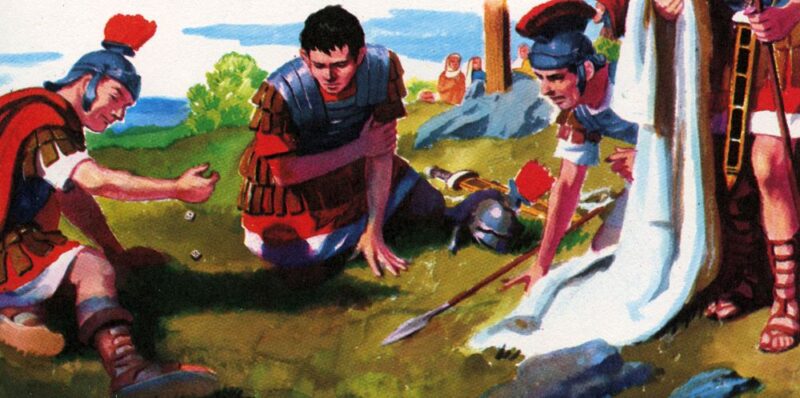
He’s not going to need them anymore.
Any rational person would have thought the same. It had happened hundreds of times before. A criminal who was crucified had no need of his personal belongings after the crucifixion. It wasn’t normal practice to let a person come off a cross alive.
A dead man does not need his clothes.
The soldiers knew this.
So, they divided the plunder…except Jesus’ clothes were not separable. The garment he was wearing wasn’t a patchwork of pieces, but rather a piece woven from top to bottom. Instead of ruining the piece, the soldiers did this.
John 19:23 When the soldiers crucified Jesus, they took his clothes, dividing them into four shares, one for each of them, with the undergarment remaining. This garment was seamless, woven in one piece from top to bottom.
24 “Let’s not tear it,” they said to one another. “Let’s decide by lot who will get it.”
Matthew’s Gospel chimes in:
Matthew 27:35 When they had crucified him, they divided up his clothes by casting lots. 36 And sitting down, they kept watch over him there.
The garment wasn’t folded up and given to Mary in honor of her son like we would a flag at the burial of a military veteran. The clothing wasn’t placed over the shoulders of one of the disciples like Elijah passing the leadership baton to Elisha. The cloth was lost to history at the hands of the Roman soldiers. We don’t even know who won the casting of lots.
So why the detail? What does the fate of Jesus’ clothing have to do with the significance of his crucifixion and work of salvation?
- The detail of prophecy is matched by the detail of fulfillment.
Jesus didn’t speak from the cross and say, “Hey soldiers, I almost forgot, but could you do me a favor and cast lots for my clothing? There’s a prophecy in the Psalms that I have to fulfill in order to get them all in and someone needs to cast lots for my clothing.” Nope. Pagan soldiers were just doing their job and getting a little extra payment for serving on the crucifixion detail. Fulfilling Scripture was the farthest thing from their mind. Yet God knew lots would be cast. The Gospel of John records and proves the truth of God’s Word and the person of Jesus to the very smallest detail.
This happened that the scripture might be fulfilled that said,
“They divided my clothes among them and cast lots for my garment. (Psalm 22:18)
So this is what the soldiers did.
- The Priest becomes the sacrifice.
One commentator noted that a seamless garment was the garb of the high priest.
The first century Jewish historian Josephus stated in his book “Antiquities (History) of the Jews” that the temple’s high priest had to wear clothes (a vestment) colored blue. This clothing was not made by pieces of cloth sewn together, or even two large pieces. It was, instead, one long vestment that was parted along the breast and back.*
Is it a subtle way the Lord communicates that Jesus who serves as our High Priest now placed himself in the role of sacrifice? Perhaps…
- No one expected Jesus to live again.
Not one of the soldiers quipped, “Hey, we can’t take this guy’s clothes. He’s going to be alive again in three days.” No one around challenged the soldiers or tried to get possession of Jesus’ clothes so he could use them again in three days. Everyone there knew the end result of Jesus’ crucifixion was death. He wouldn’t swoon, faint, or pass out. He would be dead. And dead people don’t need their clothes.
So the soldiers cast lots for his clothing.
It was all part of God’s plan to carry out every detail, fulfill every promise, and assure every person the price of death was paid for every sin.
Today we remember. Jesus died for you.
Apply: What detail of Good Friday stirs your soul today?
Prayer: Lord Jesus, thank you for humbling yourself and becoming obedient to death, even death on a cross…for me. AMEN.
This week’s devotions are based on Sunday’s Message: A Regime Change (CLICK HERE)
